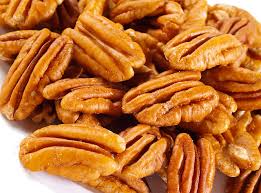 Four varieties of pecans were analyzed: Mexican Improved, Native Seedlings, Southern Improved, and Western Improved. Pecan samples (100 g) were sent to a third party laboratory for initial Salmonella screening. When a sample was positive for Salmonella, the pathogen level was determined by the most-probable-number (MPN) method (25, 2.5, and 0.25 g). Two sample preparation strategies were used for the MPN analysis, and both strategies were combined for the reported MPN values. Forty-four (0.95%) of 4,641 in-shell pecan samples were positive for Salmonella during initial screening; prevalence by year was 0.47 to 1.4%. Prevalence was not significantly different between varieties: Mexican Improved, 1.2%; Native/Seedling, 0.99%; Southern Improved, 0.97%; and Western Improved, 0.75%. Salmonella was not isolated from 31 of 44 samples upon retesting during MPN analysis (<0.47 MPN/100 g). When Salmonella was detected, the levels were 0.47 to 39 MPN/100 g, with a mean of 2.4 MPN/100 g. Thirty-one Salmonella serotypes were obtained from 42 Salmonella-positive pecan samples; Enteritidis was the most common (12% of samples) followed by Javiana (9%) and Braenderup (7%). All Salmonella Enteritidis isolates were phage type 8. Pulsed-field gel electrophoresis analysis (XbaI) revealed within-serotype diversity, indicating introduction of contamination from a variety of sources. Most (64%) of the isolates were resistant to streptomycin or tetracycline, and 13% were resistant to three or more antibiotics.
Four varieties of pecans were analyzed: Mexican Improved, Native Seedlings, Southern Improved, and Western Improved. Pecan samples (100 g) were sent to a third party laboratory for initial Salmonella screening. When a sample was positive for Salmonella, the pathogen level was determined by the most-probable-number (MPN) method (25, 2.5, and 0.25 g). Two sample preparation strategies were used for the MPN analysis, and both strategies were combined for the reported MPN values. Forty-four (0.95%) of 4,641 in-shell pecan samples were positive for Salmonella during initial screening; prevalence by year was 0.47 to 1.4%. Prevalence was not significantly different between varieties: Mexican Improved, 1.2%; Native/Seedling, 0.99%; Southern Improved, 0.97%; and Western Improved, 0.75%. Salmonella was not isolated from 31 of 44 samples upon retesting during MPN analysis (<0.47 MPN/100 g). When Salmonella was detected, the levels were 0.47 to 39 MPN/100 g, with a mean of 2.4 MPN/100 g. Thirty-one Salmonella serotypes were obtained from 42 Salmonella-positive pecan samples; Enteritidis was the most common (12% of samples) followed by Javiana (9%) and Braenderup (7%). All Salmonella Enteritidis isolates were phage type 8. Pulsed-field gel electrophoresis analysis (XbaI) revealed within-serotype diversity, indicating introduction of contamination from a variety of sources. Most (64%) of the isolates were resistant to streptomycin or tetracycline, and 13% were resistant to three or more antibiotics.
Salmonella prevalence and level on in-shell pecans is comparable to that on other nuts.
Prevalence, Level, and Types of Salmonella Isolated from North American In-Shell Pecans over Four Harvest Years
Journal of Food Protection, Number 3, March 2016, Pages 352-360, DOI: http://dx.doi.org/10.4315/0362-028X.JFP-15-365
K. Brar, L. K. Strawn, and M. D. Danyluk
http://www.ingentaconnect.com/content/iafp/jfp/2016/00000079/00000003/art00001

